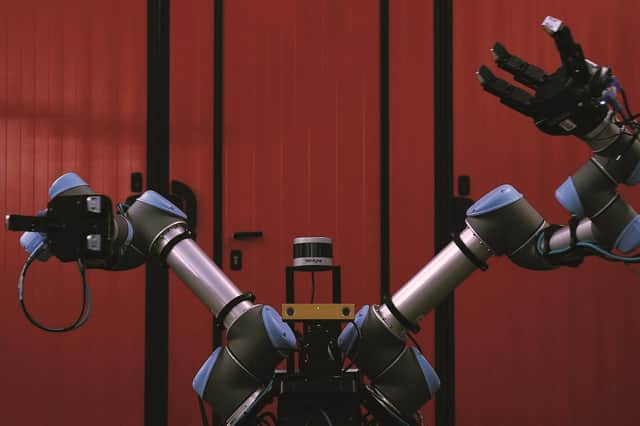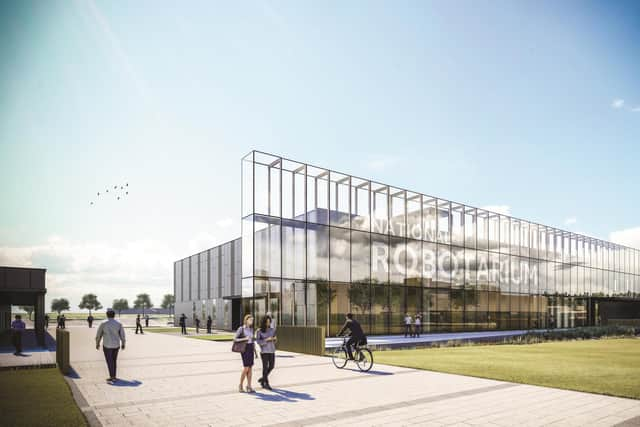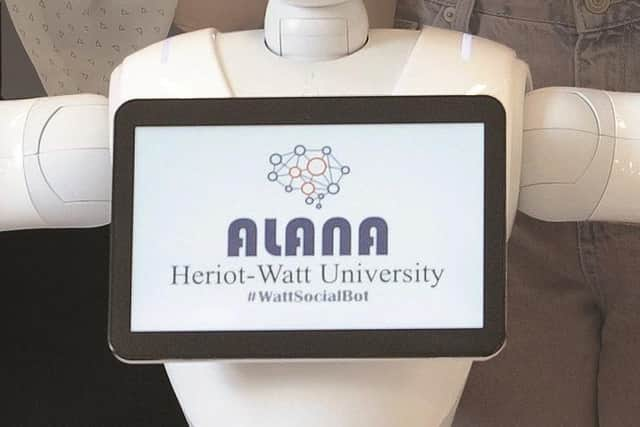How robotics could help us with the COVID crisis


Has Covid-19 started to change our attitude to robots and artificial intelligence? Researchers at Heriot-Watt University think so and are working on cutting-edge techniques to ensure a safer world for us all, with the robots doing more of the dirty and dangerous jobs.
Professor Helen Hastie, director of the EPSRC-funded Centre for Doctoral Training in Robotics and Autonomous Systems, says: “At Heriot-Watt, we have been working on getting robots to go into hazardous places where people can’t or don’t want to go, such as offshore or deep underwater.
“During the current crisis, a general awareness of the utility of robots has grown, and people can see where robots might be useful in cases when human interventions are now discouraged. This can be in particular ‘hot-zones’ that need to be avoided by people, such as homes of those shielding, and hospitals.”


One example of Heriot-Watt’s ambition is the SPRING project, where robots are designed to reduce stress and loneliness and improve sociability among elderly people in health or care settings, and the development of a “living lab”, which seeks to tackle the major challenges of providing effective care for vulnerable people.
This research takes place in a partnership between Heriot-Watt and Edinburgh universities, known as the Edinburgh Centre of Robotics (ECR), and this is the foundation of the new National Robotarium.
This multi-million-pound, purpose-built centre of excellence in UK robotics, is being developed on the outskirts of Edinburgh, on the Heriot-Watt campus, as part of the Edinburgh and South-East Scotland City Region Deal.
Opening in 2022, the National Robotarium is a test bed to translate world-leading research and development around interaction between humans, robots and their environments into technology, innovation and sustainable economic and societal benefits.


The new building will be open to industry, visiting researchers and the public, who will be able to interact with a wide range ofworld-class robots.
Offering state-of-the-art rapid prototyping facilities, living labs and more, The National Robotarium will provide flexible opportunities to develop technology and ultimately to deliver robots to the marketplace.
“Scotland is increasingly the place to come for great young minds in robotics” says Hastie.
The Centre for Doctoral Training is attracting this fresh talent. It is now into its sixth cohort, with over 130 funded places for students working on robotics and AI until 2028. Ten industry partners already provide support, with the centre advisory group also including private sector representatives from Honda and Dyson.


This model of wide-ranging private sector involvement is crucial to the National Robotarium’s goal of delivering economic benefits from robotics to the Edinburgh city region.
“Beyond core robotics training, students have access to a fund to seed innovative ideas to create businesses,” says Hastie.
“We want students to be innovation-ready, to come up with great ideas to launch businesses and add value in the Edinburgh city region, and for their projects to spawn joint working with industry.”
In the Offshore Robotics for Certification of Assets Hub (ORCA), the ECR and National Robotarium teams are leading collaborations with 30 private firms and other universities. They are developing autonomous and semi-autonomous smart machines that can inspect and repair offshore structures above and below the water.
As robots start to enter our everyday lives, Hastie insists it is vital that an ethical dimension underpins the work.
She says: “Responsible research and innovation is embedded in all our programmes – and as robots move into more home and workplace settings, that raises fundamental issues about how robots interact safely with humans, in terms of the environment and physical interaction.
“Robots have a certain amount of autonomy but ultimately there is a human in the loop – and we are researching the best way for humans and robots to work seamlessly together.”
During the coronavirus pandemic, teams have utilised Digital Twin technology to develop and test prototypes from their homes before progressing to testing in the real world. This makes it much faster to re-purpose smart machines for new applications or customers. Achieving this increases resilience to large economic shocks, and creates new market opportunities.
Smart machines can play an essential role improving our resilience in the low-touch economy of our post-Covid world.
They can assist humanity by disinfecting hospitals, moving and organising goods in warehouses, maintaining offshore energy infrastructures and supporting surgical procedures.
“This work isn’t about superhuman robots running our lives,” Hastie comments. “But robotics as an economic and social driver, with research, innovation and business delivering real benefits for society.”
SPRING: FORWARDS TO BETTER SOCIAL COHESION
Can social robots help connect people with each other, and healthcare professionals, as they get older?
SPRING, a European Horizon 2020 project – and the first announced by the National Robotarium – hopes they can.
Professor Oliver Lemon of Heriot-Watt University says: “Research shows careful use of robots in group settings can have a positive impact on health, such as decreased stress and loneliness, and improved mood and sociability.
“Robot companionship has long-term potential to better connect people with each other. Social robots could improve both psychological wellbeing and relationships between patients and hospital professionals.”
Lemon adds: “Overcoming the limitations of current social robots raises numerous scientific and technological challenges.” But he maintains that they have the potential to create tremendous social impact and economic value.
The technology – which builds on the success of Heriot-Watt University’s Amazon Alexa Prize conversational AI system and spin-out company Alana – is touch and hands-free so will reduce the spread of infection.
SPRING (Socially Pertinent Robots in Gerontological Healthcare) is part of a multi-million-pound collaboration, funded by Horizon2020 and involving experts from Scotland, France, Italy, Czech Republic, Israel and Spain. It fuses research into conversational AI, computer vision, machine learning and human-robot interaction, alongside human behaviour analysis and robot control.
The work will focus on helping social robots understand individual and group situations and to make appropriate decisions, such as identifying and prioritising patients who have been waiting alone for a long time or who might be anxious.
Social robots will engage face-to-face with patients, family members and staff.See www.alanaai.com
Living Lab works to improve quality of life
The challenges of caring for vulnerable people with specific needs have been highlighted by the Covid-19 pandemic – and a National Robotarium project is looking to address them.
The project will initially support priority groups whose conditions have been compounded by social isolation, including people with multi-morbidity conditions, disabilities, and those in acute stages of mental ill health.
Heriot-Watt is the base for a world-first “living lab” to research and create solutions for Ambient Assisted Living (OpenAAL) – concepts, products and services combining new technologies and the social environment to improve quality of life.
The “living lab” will target practical solutions using a range of technologies to enable non-intrusive monitoring of behaviour and vital signs, detect patterns and trends in behaviour, support decision-making and risk assessment, aid communication and social connectedness, and provide social, cognitive and physical assistance.
The project is funded by the Engineering and Physical Sciences Research Council and has support from NHS Lothian, The Digital Health and Care Institute, Blackwood Home and Care Group, Consequential Robotics, Alcuris, Cyberselves and The Data Lab – Scotland’s innovation centre for data and AI.
Dr Mauro Dragone, assistant professor at Heriot-Watt University and OpenAAL project lead, says: “There is huge potential to unify efforts and provide better support to the nation’s most vulnerable. We have the opportunity to tackle current challenges head-on, but also establish long-term, cost-effective solutions to wider challenges.
“Successful innovation in this field is crucial to alleviate the strain on our health and social care services. Our priority is solutions which are practical and feasible, so they can be quickly implemented in the face of challenging social and economic conditions.”
The OpenAAL lab, launched in July, will use Digital Twin, Internet of Things and Cloud technology to provide a platform where researchers, industry and care providers, and end users of assisted living services, can co-create technology.
As the project expands, it is hoped it will be used for global collaboration, removing time and distance barriers to research and innovation.
For more information, visit the Heriot-Watt National Robotorium website